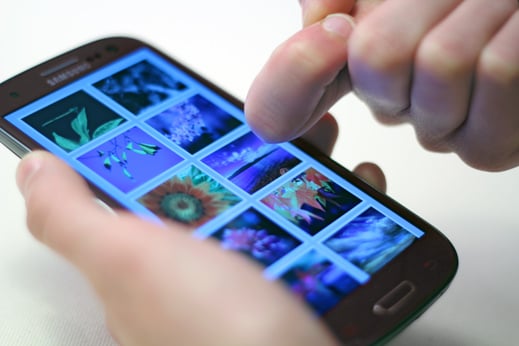Actualele ecrane tactile sunt capabile sa recunoasca apasarile facute de utilizatori si in baza lor sa faca diverse actiuni, insa sistemul nu poate distinge intre o apasare facuta cu degetul, cu unghia sau cu palma. O noua companie americana doreste sa rezolve aceasta problema si a dezvoltat un sistem care este capabil sa distinga daca un ecran este atins cu unghia, cu partea laterala a degetului, cu palma sau cu partea superioara a degetului, iar aici sta viitorul ecranelor pentru terminale mobile.
There’s more to our fingers than just the tips, though, and a startup called Qeexo aims to take advantage of this with technology that can differentiate between fingertips, nails, and knuckles. The San Jose, California-based company’s technology, called FingerSense, can be used to do things like bring up a menu of options (akin to right-clicking on a mouse) on an e-mail with the knock of a knuckle, or enable new kinds of controls in games. Currently in talks with phone manufacturers, Qeexo hopes to have FingerSense installed in smartphones within a year.
Prin recunoasterea modului in care este atins un ecran, sistemul poate actiona diverse functii ale unui sistem de operare. Practic o atingere cu partea superioara a degetului ar deschide o aplicatie sau ar selecta o optiune, insa atingerea facuta cu unghia sau cu partea laterala a degetului ar deschide un meniu de optiuni sau ar actiona functia de copiere sau lipire a textului si exemplele pot continua. Ecranele de acest gen ar extinde functionalitatea unui terminal mobil, insa totul depinde si de modul in care dezvoltatorii OS-urilor mobile stiu sa il implementeze.
The project got them thinking about how such technology could be used to differentiate between different parts of the finger on a smartphone screen. Qeexo’s technology relies in part on an acoustic sensor that can capture the sounds—mechanical vibrations—made by different types of on-screen touches from the different parts of a finger. Software on the phone, which has been trained with multiple people to tell the difference between various touches, uses information gathered by the acoustic sensor, along with data like where the touch occurred and how big it was, to make an educated guess about how a person is touching the screen.
Actualele sisteme de operare pentru terminale mobile sunt limitate, nu pot oferi utilizatorilor functionalitatea ce in mod normal se regaseste intr-un OS pentru desktop-uri, iar acest sistem poate rezolva problema. Cred ca prima companie care va implementa asa ceva in dispozitivele sale va “revolutiona” industria terminalelor mobile, insa totul depinde de cat de bine va fi implementat sistemul.






















